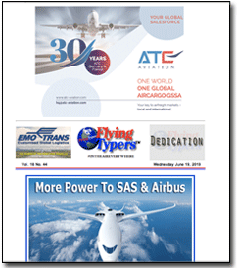|
Air cargo rates continue to see weekly
volatility, but with the demand outlook tepid and ample capacity
available on most lanes, pricing continues to fluctuate, albeit within
boundaries far below those enjoyed in 2018.
Flex Sees
Stable
Capacity out of most Asian origins was reported
by Flexport to be “stable” at the end of June with capacity
available. The exception was Central China where demand was strong and
rates going up as Apple, HP and other electronics shippers exported to
the U.S. ahead of anticipated tariffs.
Rating The Traffic
Hong Kong–U.S. rates reached $3.39
per kg at the start of July after hovering in the $3.27-3.55 per kg range
through June, according to TAC Index.
By comparison, rates on the same lane were
$3.66 per kg on July 2, 2018 and were just about to embark on a Himalayan
traverse to the heights of $5.73 per kg in November.
Hong Kong–Europe rates are also volatile,
climbing slightly over the previous week to reach $2.74 per kg at the
start of July, still a long way short of the $3.77 per kg recorded in
December last year, although level compared to a year ago.
Demand Driven
Summer Lull?
As guides go, year-on-year pricing comparisons
are tough on an air freight market that saw such an elongated demand spike
last year thanks, mostly, to the U.S.-China trade war.
Desperate frontloading on the Asia to North
America trade lane ahead of various tariff deadlines in the second half
of the year saw ocean supply chains suffer congestion and delays at ports,
adding to modal shift and sucking capacity out of global air freight markets.
Forward Comparison
Looks At 2017
By contrast, some analysts believe that
comparisons to 2017 – a more traditional year for air freight demand
- illustrate that the Transpacific market now is less bearish than year-on-year
comparisons suggest, while Europe, subject of continuously poor economic
projections, is in fact currently performing satisfactorily.
And there is some truth in this: rates at
the start of July 2017 on the Hong Kong–U.S. and Hong Kong–Europe
lanes $3.36 per kg and $2.27 per kg, respectively.
Eliminate
Extremes
WorldACD made much the same point in its
latest report, which takes in the first five months of 2019. “Let’s
join the people who find that a comparison with 2017 is more ‘realistic’
than a comparison with 2018, given last year’s ‘extreme’
growth figures,” huffed its latest report.
“Compared with Jan-May 2017, the year
2019 so far shows worldwide growth of +1%. Moreover, 22 of the 40 largest
air cargo countries in the world show positive growth for the same period.
The growth percentages between 2017 and
2019 range from 32.6% for Chile to 0.1% for India.”
However, although comparisons versus 2017
add context, there is no disguising the slowdown the market has suffered
so far this year.
In the month of May, WorldACD found that
total chargeable weight again fell compared to the same period of 2018,
this time by 5%. Yields in USD fell by 5.6%, resulting in revenue loss
for airlines of more than 10% year-on-year.
 |
Nowhere To
Run Nowhere To Hide
“Not a single region escaped the trend:
the origins Africa and Europe suffered least, with year-on-year volume
drops of 2.2% and 2.4% respectively, but the origins Asia Pacific and
North America chalked up year-on-year losses of -7.0 % and -7.2 % respectively,”
it said.
“Latin America and the Middle East
& South Asia (MESA) could not buck the trend either (-4% and -3.4%).”
Word From
Mount IATA
IATA reported a 3.4% year-on-year in global
demand in May, a slight improvement on the 5.6% contraction in April.
However, capacity growth outstripped demand
growth for the 13th consecutive month, up 1.3% year-on-year in May.
IATA said air cargo demand had suffered
from very weak global trade volumes and trade tensions between the U.S.
and China. “This has contributed to declining new export orders,”
it noted. “The indicator for new manufacturing export orders, part
of the global Purchasing Managers Index (PMI), has indicated falling orders
since September 2018.”
Alexandre de Juniac, IATA's Director General
and CEO, said the impact of the U.S.-China trade war on air freight volumes
in May was clear. “Year-on-year demand fell by 3.4%,” he said.
“It’s evidence of the economic
damage that is done when barriers to trade are erected. Renewed efforts
to ease the trade tensions coming on the sidelines of the G20 meeting
are welcome. But even if those efforts are successful in the short-term,
restoring business confidence and growing trade will take time. And we
can expect the tough business environment for air cargo to continue.”
Looking For
The Light
Optimism elsewhere is difficult to find.
“[The] market price recovery continues, however changes aren't significant
enough to indicate an airfreight recovery,” commented Peter Stallion,
an air cargo derivatives broker at Freight Investor Services.
WorldACD added: “Writing this message
at the half-way point for the year 2019, it is difficult to believe that
the year will recover from its dismal start.”
SkyKing
|




 Vol.
18 No. 44
Vol.
18 No. 44